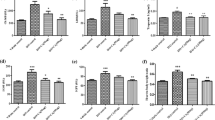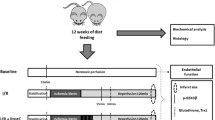Abstract
Background and aim
Apoptosis is a major cause of myocyte death, and taurine is anti-apoptotic. Heat shock protein 70 (HSP70) (which is regulated by heat shock factor—HSF-1) is also anti-apoptotic, and caspase 3 stimulates the apoptotic pathway. This study investigated whether taurine affects atherogenic diet-induced myocardial apoptosis, and whether HSP70, HSF-1 and caspase 3 are involved.
Methods
New Zealand white rabbits were divided into 3 groups for 4 weeks according to their diet. Group 1 (control) was fed a normal rabbit diet; Group 2 (MC) received a normal rabbit diet with 1 % methionine plus 0.5 % cholesterol. Group 3 received MC diet + 2.5 % taurine (MCT).
Results
The atherogenic diet did not affect myocardial HSP70 or HSF-1 protein, but increased myocardial apoptotic nuclei to 40 % (p < 0.01) versus 7 % in con and 12 % in MCT (p < 0.01). However, in MCT, myocardial HSP70 expression increased by 42.7 % versus con and MC (p = 0.016), HSF-1 by 12 % versus con and MC (p < 0.05), and total nuclei count increased by 37 % versus MC (p < 0.05). Caspase 3 subunits remained unchanged in all groups, and HSP70 was increased approximately twofold in endothelial layer of arterioles (p = 0.01).
Conclusion
This study shows that taurine could reduce myocardial apoptotic nuclei and thus confer myocardial cytoprotection via stimulating myocardial HSP70 via HSF-1 and caspase 3-independent mechanisms.



Similar content being viewed by others
References
Tsutsui H, Ide T, Hayashidani S, Suematsu N, Utsumi H, Nakamura R, Egashira K, Takeshita A (2001) Greater susceptibility of failing cardiac myocytes to oxygen free radical-mediated injury. Cardiovasc Res 49:103–109
Csont T, Bereczki E, Bencsik P, Fodor G, Gorbe A, Zvara A, Csonka C, Puskas LG, Santha M, Ferdinandy P (2007) Hypercholesterolemia increases myocardial oxidative and nitrosative stress thereby leading to cardiac dysfunction in apoB-100 transgenic mice. Cardiovasc Res 76:100–109
Ferdinandy P (2003) Myocardial ischaemia/reperfusion injury and preconditioning: effects of hypercholesterolaemia/hyperlipidaemia. Br J Pharmacol 138:283–285
Szilvassy Z, Ferdinandy P, Szilvassy J, Nagy I, Karcsu S, Lonovics J, Dux L, Koltai M (1995) The loss of pacing-induced preconditioning in atherosclerotic rabbits: role of hypercholesterolaemia. J Mol Cell Cardiol 27:2559–2569
Onody A, Csonka C, Giricz Z, Ferdinandy P (2003) Hyperlipidemia induced by a cholesterol-rich diet leads to enhanced peroxynitrite formation in rat hearts. Cardiovasc Res 58:663–670
Havel PJ (2005) Dietary fructose: implications for dysregulation of energy homeostasis and lipid/carbohydrate metabolism. Nutr Rev 63:133–157
Nittynen L, Nurminen ML, Korpela R, Vapaatalo H (1999) Role of arginine, taurine and homocysteine in cardiovascular diseases. Ann Med 31:318–326
Yamori Y, Nara Y, Ikeda K, Mizushima S (1996) Is taurine a preventive nutritional factor of cardiovascular diseases or just a biological marker of nutrition? Adv Exp Med Biol 403:623–629
Tsuboyama-Kasaoka N, Shozawa C, Sano K, Kamei Y, Kasaoka S, Hosokawa Y, Ezaki O (2006) Taurine (2-aminoethanesulfonic acid) deficiency creates a vicious circle promoting obesity. Endocrinology 147:3276–3284
Nandhini AT, Thirunavukkarasu V, Anuradha CV (2004) Stimulation of glucose utilization and inhibition of protein glycation and AGE products by taurine. Acta Physiol Scand 181:297–303
Zulli A, Hare DL, Buxton BF, Black MJ (2004) High dietary methionine plus cholesterol exacerbates atherosclerosis formation in the left main coronary artery of rabbits. Atherosclerosis 176:83–89
Zulli A, Widdop RE, Hare DL, Buxton BF, Black MJ (2003) High methionine and cholesterol diet abolishes endothelial relaxation. Arterioscler Thromb Vasc Biol 23:1358–1363
Lonn E, Yusuf S, Arnold MJ, Sheridan P, Pogue J, Micks M, McQueen MJ, Probstfield J, Fodor G, Held C, Genest J Jr (2006) Homocysteine lowering with folic acid and B vitamins in vascular disease. N Engl J Med 354:1567–1577
Oudit GY, Trivieri MG, Khaper N, Husain T, Wilson GJ, Liu P, Sole MJ, Backx PH (2004) Taurine supplementation reduces oxidative stress and improves cardiovascular function in an iron-overload murine model. Circulation 109:1877–1885
Chang L, Xu J, Yu F, Zhao J, Tang X, Tang C (2004) Taurine protected myocardial mitochondria injury induced by hyperhomocysteinemia in rats. Amino Acids 27:37–48
Tavazzi L, Maggioni AP, Marchioli R, Barlera S, Franzosi MG, Latini R, Lucci D, Nicolosi GL, Porcu M, Tognoni G (2008) Effect of n-3 polyunsaturated fatty acids in patients with chronic heart failure (the GISSI-HF trial): a randomised, double-blind, placebo-controlled trial. Lancet 372:1223–1230
Powers MV, Workman P (2007) Inhibitors of the heat shock response: biology and pharmacology. FEBS Lett 581:3758–3769
Latchman DS (2001) Heat shock proteins and cardiac protection. Cardiovasc Res 51:637–646
Moretti A, Weig HJ, Ott T, Seyfarth M, Holthoff HP, Grewe D, Gillitzer A, Bott-Flugel L, Schomig A, Ungerer M, Laugwitz KL (2002) Essential myosin light chain as a target for caspase-3 in failing myocardium. Proc Natl Acad Sci USA 99:11860–11865
Ghosh J, Das J, Manna P, Sil PC (2009) Taurine prevents arsenic-induced cardiac oxidative stress and apoptotic damage: role of NF-kappa B, p38 and JNK MAPK pathway. Toxicol Appl Pharmacol 240:73–87
Zulli A, Buxton BF, Black MJ, Ming Z, Cameron A, Hare DL (2006) The immunoquantification of caveolin-1 and eNOS in human and rabbit diseased blood vessels. J Histochem Cytochem 54:151–159
Zulli A, Buxton BF, Black MJ, Hare DL (2008) Embryonic stem cells markers are present within rabbit atherosclerotic plaques. Histol Histopathol 23:741–746
Wookey PJ, Zulli A, Buxton BF, Hare DL (2008) Calcitonin receptor immunoreactivity associated with specific cell types in diseased radial and internal mammary arteries. Histopathology 52:605–612
Zinellu A, Sotgia S, Usai MF, Zinellu E, Posadino AM, Gaspa L, Chessa R, Pinna A, Carta F, Deiana L, Carru C (2007) Plasma methionine determination by capillary electrophoresis-UV assay: application on patients affected by retinal venous occlusive disease. Anal Biochem 363:91–96
Zinellu A, Carru C, Galistu F, Usai MF, Pes GM, Baggio G, Federici G, Deiana L (2003) N-methyl-D-glucamine improves the laser-induced fluorescence capillary electrophoresis performance in the total plasma thiols measurement. Electrophoresis 24:2796–2804
Edinger AL, Thompson CB (2004) Death by design: apoptosis, necrosis and autophagy. Curr Opin Cell Biol 16:663–669
Frankfurt O, Krishan A (2008) Application of anti-ssDNA monoclonal antibody to study exogenous and apoptosis-associated DNA damage. Cytometry A 73A:1114–1115
Salim EI, Morimura K, Menesi A, El-Lity M, Fukushima S, Wanibuchi H (2008) Elevated oxidative stress and DNA damage and repair levels in urinary bladder carcinomas associated with schistosomiasis. Int J Cancer 123:601–608
Lapinski TW, Wiercinska-Drapalo A, Panasiuk A, Kovalchuk O (2007) Concentrations of ssDNA in liver tissue and its correlation with sFas and sFasL in serum of patients infected with HBV, HCV, HCV and HIV. Adv Med Sci 52:109–113
Zulli A, Hare DL, Buxton BF, Black MJ (2006) The combination of high dietary methionine plus cholesterol induces myocardial fibrosis in rabbits. Atherosclerosis 185:278–281
Yang Q, Yang J, Wu G, Feng Y, Lv Q, Lin S, Hu J (2013) Effects of taurine on myocardial cGMP/cAMP ratio, antioxidant ability, and ultrastructure in cardiac hypertrophy rats induced by isoproterenol. Adv Exp Med Biol 776:217–229
Schaffer SW, Jong CJ, Ito T, Azuma J (2012) Effect of taurine on ischemia-reperfusion injury. Amino Acids. doi:10.1007/s00726-012-1378-8
Budihardjo I, Oliver H, Lutter M, Luo X, Wang X (1999) Biochemical pathways of caspase activation during apoptosis. Annu Rev Cell Dev Biol 15:269–290
Bae S, Yalamarti B, Kang PM (2008) Role of caspase-independent apoptosis in cardiovascular diseases. Front Biosci 13:2495–2503
Choudhury S, Bae S, Kumar SR, Ke Q, Yalamarti B, Choi JH, Kirshenbaum LA, Kang PM (2010) Role of AIF in cardiac apoptosis in hypertrophic cardiomyocytes from Dahl salt-sensitive rats. Cardiovasc Res 85:28–37
Siu PM, Bae S, Bodyak N, Rigor DL, Kang PM (2007) Response of caspase-independent apoptotic factors to high salt diet-induced heart failure. J Mol Cell Cardiol 42:678–686
Kim NH, Kang PM (2010) Apoptosis in cardiovascular diseases: mechanism and clinical implications. Korean Circ J 40:299–305
Zulli A, Lau E, Wijaya BP, Jin X, Sutarga K, Schwartz GD, Learmont J, Wookey PJ, Zinellu A, Carru C, Hare DL (2009) High dietary taurine reduces apoptosis and atherosclerosis in the left main coronary artery: association with reduced CCAAT/enhancer binding protein homologous protein and total plasma homocysteine but not lipidemia. Hypertension 53:1017–1022
Ito T, Kimura Y, Uozumi Y, Takai M, Muraoka S, Matsuda T, Ueki K, Yoshiyama M, Ikawa M, Okabe M, Schaffer SW, Fujio Y, Azuma J (2008) Taurine depletion caused by knocking out the taurine transporter gene leads to cardiomyopathy with cardiac atrophy. J Mol Cell Cardiol 44:927–937
Mayer MP, Bukau B (2005) Hsp70 chaperones: cellular functions and molecular mechanism. Cell Mol Life Sci 62:670–684
Arya R, Mallik M, Lakhotia SC (2007) Heat shock genes—integrating cell survival and death. J Biosci 32:595–610
Falktoft B, Lambert IH (2004) Ca2+-mediated potentiation of the swelling-induced taurine efflux from HeLa cells: on the role of calmodulin and novel protein kinase C isoforms. J Membr Biol 201:59–75
Li F, Obrosova IG, Abatan O, Tian D, Larkin D, Stuenkel EL, Stevens MJ (2005) Taurine replacement attenuates hyperalgesia and abnormal calcium signaling in sensory neurons of STZ-D rats. Am J Physiol Endocrinol Metab 288:E29–E36
Silomon M, Bauer I, Bauer M, Nolting J, Paxian M, Rensing H (2007) Induction of heme oxygenase-1 and heat shock protein 70 in rat hepatocytes: the role of calcium signaling. Cell Mol Biol Lett 12:25–38
Chang YS, Lee LC, Sun FC, Chao CC, Fu HW, Lai YK (2006) Involvement of calcium in the differential induction of heat shock protein 70 by heat shock protein 90 inhibitors, geldanamycin and radicicol, in human non-small cell lung cancer H460 cells. J Cell Biochem 97:156–165
Pinton P, Giorgi C, Siviero R, Zecchini E, Rizzuto R (2008) Calcium and apoptosis: ER-mitochondria Ca2+ transfer in the control of apoptosis. Oncogene 27:6407–6418
Gurbuxani S, Schmitt E, Cande C, Parcellier A, Hammann A, Daugas E, Kouranti I, Spahr C, Pance A, Kroemer G, Garrido C (2003) Heat shock protein 70 binding inhibits the nuclear import of apoptosis-inducing factor. Oncogene 22:6669–6678
Ruchalski K, Mao H, Li Z, Wang Z, Gillers S, Wang Y, Mosser DD, Gabai V, Schwartz JH, Borkan SC (2006) Distinct hsp70 domains mediate apoptosis-inducing factor release and nuclear accumulation. J Biol Chem 281:7873–7880
Morakinyo MK, Strongin RM, Simoyi RH (2010) Modulation of homocysteine toxicity by S-nitrosothiol formation: a mechanistic approach. J Phys Chem B 114:9894–9904
Jakubowski H (1990) Proofreading in vivo: editing of homocysteine by methionyl-tRNA synthetase in Escherichia coli. Proc Natl Acad Sci USA 87:4504–4508
Brosnan JT, Brosnan ME (2006) The sulfur-containing amino acids: an overview. J Nutr 136:1636S–1640S
Ito T, Schaffer S, Azuma J (2013) The effect of taurine on chronic heart failure: actions of taurine against catecholamine and angiotensin II. Amino Acids. doi:10.1007/s00726-013-1507-z
Acknowledgments
We acknowledge the infrastructure support from Professor David Hare. As well, we acknowledge the technical support of Kenneth Leong, Gary Tan, Angela Kourakis, Zamzania Shalih, Widya Simatupang, Felix Dalimartha, and Ira Muchji. This work was supported by the National Health Medical Research Council and National Heart Foundation of Australia.
Conflict of interest
None.
Author information
Authors and Affiliations
Corresponding author
Rights and permissions
About this article
Cite this article
Setyarani, M., Zinellu, A., Carru, C. et al. High dietary taurine inhibits myocardial apoptosis during an atherogenic diet: association with increased myocardial HSP70 and HSF-1 but not caspase 3. Eur J Nutr 53, 929–937 (2014). https://doi.org/10.1007/s00394-013-0596-5
Received:
Accepted:
Published:
Issue Date:
DOI: https://doi.org/10.1007/s00394-013-0596-5




